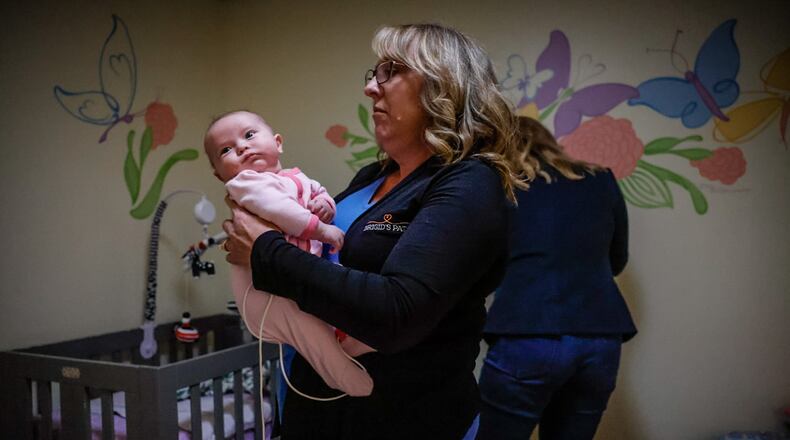Jill Kingston, founder and president of Brigid’s Path, saw a need for this type of facility after fostering multiple infants who had been exposed to addictive substances while still in utero.
“I had been fostering and ran into lack of support, lack of education,” Kingston said. Through fostering, she saw the newborns’ experiences in the hospital and with children services, as well as their families’ experiences with children services.
“I just felt a bigger calling to do something,” Kingston said. “At that time, I didn’t know what it was.”
In 2014, Kingston began planning for Brigid’s Path, named for St. Brigid, a saint related to patron of babies. The newborn recovery center was modeled after a facility in West Virginia called Lily’s Place. Other facilities in Arizona and Washington have since designed their centers based on Brigid’s Path and Lily’s Place.
“The community just surrounded us,” Kingston said about the support the center received, which included the donation of the building they’re located at in Kettering.
It wouldn’t be for a couple more years until they welcomes their first baby to the center on Dec. 29, 2017.
“He just turned six,” Kingston said. Brigid’s Path has stayed in touch with him and others they have helped.
Credit: JIM NOELKER
Credit: JIM NOELKER
Right now, Brigid’s Path is funded through grants and donations, and they are working with the Ohio Department of Medicaid to be able to receive Medicaid funds in the future.
“Medicaid doesn’t have the rules and rates written for an organization like us, nothing like this exists,” Kingston said. Brigid’s Path is currently drafting the rules and rates on their end, hoping to get Medicaid approval in 2024.
A third nursery is ready at the facility to house more newborns who need the specialized care they offer, but they’re not able to afford staffing that nursery yet.
Newborns can stay at Brigid’s Path for up to 90 days, and mothers can room with them, Kingston said.
About 85% of the babies get to go home to family, such as parents or other kinship arrangements, after their stay at Brigid’s Path.
“That’s probably one of the things we do really well. We work with children services to make sure babies don’t have to go into the foster care system,” Kingston said.
Of those 85%, Kingston estimated about 70% of them would have had to go into the foster care system had they not first gone to Brigid’s Path.
Credit: JIM NOELKER
Credit: JIM NOELKER
Staff and volunteers who have been with Brigid’s Path since the beginning say the journey has been memorable, as well as agree this was something they felt called to do.
“For me, I do have specific babies that stick out in my mind,” said Shelly Decker, a nurse at Brigid’s Path. “Maybe their withdrawal was really difficult and we did a lot to help them.”
She also remembers babies when they were nearing their discharge date, saying some were almost a completely different baby than when they arrived because they’re not in pain anymore and can show their personality.
“Which is amazing to see,” Decker said.
Credit: JIM NOELKER
Credit: JIM NOELKER
Brigid’s Path has a variety of techniques they use to help soothe the newborns, keeping them as comfortable as possible while using the least amount of medication they can, she said.
“Our goal here is to use the least amount of medications as possible and use what’s called non-pharmacological care, so that would be the holding, the cuddling, a dark room, a quiet room, a hot bath,” Decker said.
If the babies don’t have family or caregivers coming in as often, staff and volunteers may form bonds with those infants, too.
“I definitely have some that are in my heart that will always be there,” Decker said.
Marcy Miller, who is currently a volunteer cuddler for the babies, has been in a number of roles at the center after her family encouraged her to volunteer at Brigid’s Path, including a former board member and treasurer for Brigid’s Path.
“I love babies, and that’s really where the memories are for me,” said Miller, who is one of more than 80 volunteers at Brigid’s Path. It is a rewarding experience for her to watch the babies recover and families bond with them, she said.
“For me, actually, I feel like I get more out of maybe what I do for the babies or in helping the staff because there’s something about taking yourself away from all the noise in the world and doing good,” Miller said.
For more information about Brigid’s Path, visit brigidspath.org.
About the Author




